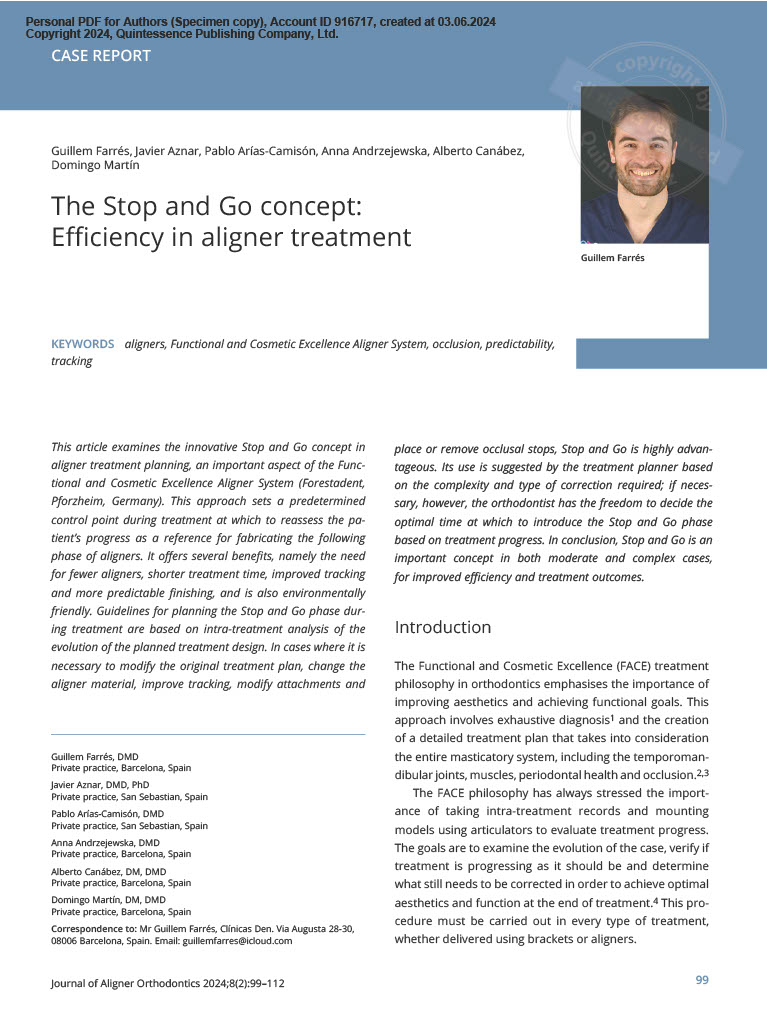Paper language: English
Paper language: Spanish
Paper language: English and spanish

Tratamiento integral de la maloclusión en el síndrome de Turner. A propósito de un caso
AUTHOR: Raul Ferrando Cascales, Domingo Martin Salvador, Benito Ramos Medina y Alvaro Ferrando Cascales
English abstract
Introduction. Turner syndrome (ST) was described in 1938. It affects only females and its main feature is the absence of one X chromosome in the karyotype of the patients. The maxillofacial aspect usually presents biretrusion and open bite with a relation of Class II between maxilla and mandible. Case report. We treated a case of ST with open bite, maxillary hypoplasia open bite, and hypoplasia of enamel using a combined treatment of orthodontics, orthognathic surgery and prosthetic rehabilitation. Clinical picture. Patient of 16 years affected ST (45, X0). Presents biretrusive profile with labial incompetence and appearance of Class III, Class I molar occlusion with bilateral posterior crossbite and open bite from the teeth 15-25. Treatment. a) orthopedic phase: disjunction maxilla; b) orthodontic phase: correction of dental axs; c) surgical phase: four maxilla orthognathic surgery, and d) prosthetic phase: dental rehabilitation. Results. Orthopedic phase: we obtained a disjunction of 6 mm among canines and 2.5 mm at the posterior nasal spine. Orthodontic phase: dental axs were corrected within the limitations of treatment. Surgical phase: using segmentation in 4 of the upper jaw, we got an expansion of 8 mm and closed the bite. Prosthetic phase: dental aesthetics was improved and the patient was provided of functional guides. Discussion. Due to the age of the patient (16), the choice between doing a disjunction or a conventional maxillary expansion surgically assisted is controversial. (Rev Esp Ortod. 2013;43:107-14). Corresponding author: Raúl Ferrando Cascales, [email protected] Key words: Turner syndrome. Malocclusion. Treatment. Craneofacial morphology.Spanish abstract
Introducción. El síndrome de Turner (ST) fue descrito en 1938. Solo afecta al sexo femenino, y su principal característica es la ausencia de un cromosoma X en el cariotipo de las pacientes. A nivel maxilofacial suelen presentar birretrusión y mordida abierta con una relación de Clase II entre maxilar y mandíbula. Informe del caso. Hemos tratado un caso de ST con mordida abierta, hipoplasia maxilar, mordida abierta e hipoplasia de esmalte mediante un tratamiento combinado de ortodoncia, cirugía ortognática y rehabilitación protésica. Cuadro clínico. Paciente de 16 años afectada de ST (45, X0). Presenta perfil birretrusivo con incompetencia labial y apariencia de Clase III, oclusión Clase I molar con mordida cruzada posterior bilateral y mordida abierta desde los dientes 15-25. Tratamiento. a) fase ortopédica: disyunción maxilar; b) fase ortodóncica: corrección de ejes dentales; c) fase quirúrgica: cirugía ortognática maxilar, y d) fase protésica: rehabilitación dental. Resultados. Fase ortopédica: se obtuvo una disyunción de 6 mm a nivel de caninos y de 2,5 mm a nivel de espina nasal posterior. Fase ortodóncica: fueron corregidos los ejes dentales dentro de las limitaciones de tratamiento. Fase quirúrgica: mediante segmentación en 4 del maxilar superior, se obtuvo una expansión adicional de 8 mm y se cerró la mordida. Fase protésica: fue mejorada la estética dental de la paciente y se la dotó de guías funcionales. Discusión. Debido a la edad de la paciente (16), la elección entre realizar una disyunción maxilar convencional o una expansión asistida quirúrgicamente es controvertida. Palabras clave: Síndrome de Turner. Maloclusión. Tratamiento. Morfología craneofacial.Download paper (PDF)
Access our most valuable content free of charge.
Related Scientific papers
1st FACE online symposium
The world is changing and in FACE, following tradition, we wont be left behind.
As we all know, we can’t travel or meet, so once again, we will take advantage of technology to turn the situation around.
«Work hard, play hard«
Two days full of experiences, thanks to the participation of 20 different clinics.
We’ll see you on February 26 and 27





